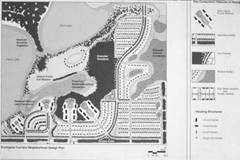 |
||
Overview Featured Research Publications
|
Landscape Ecology: Planning and Design
Aligning Social and Ecological Drivers of Urban Landscape Change: The Calumet Urban Riparian Area (Joan Iverson Nassauer) This project proposes landscape ecological design innovations for brownfield industrial parks and tests those innovations against the perceptions of stakeholders using focus group and web-based survey methods. <return to top>
Biocomplexity at the Interface of Social and Ecological Systems (Joan Iverson Nassauer with Dan Brown, David Allan, Tom Crow, and Steven Yaffee) This project is a collaboration that exemplifies interdisciplinary work among colleagues in the School to identify approaches to understanding and influencing human social issues, perceptions, and behaviors as they effect ecological function at landscape scales. <return to top>
Cultural Indicators of Landscape Ecological Health (Joan Iverson Nassauer) This project examines how everyday perceptions and landscape behaviors might be cultural indicators of landscape ecological health. The goal is to identify measurable cultural variables that affect landscape ecological trends, which could be used as both a forecasting and a monitoring tool for policy interventions. <return to top>
Development and Testing of a Decision-Support System for River Restoration (Joan Iverson Nassauer with David Allan, Andrew Brenner, and Gloria Helfand) This project is investigating alternative residential landscapes designed to mitigate the effects of urban sprawl, their social and economic acceptability, and their ecological impacts, in order to create a decision support system that will enable citizens and agencies to identify innovative approaches to maintaining the ecological health of the Huron and Raisin River areas while enhancing the quality of residential life. For more information on the decision-support system, visit the project website. <return to top>
Infrastructure for Ecological Quality in Your Neighborhood (Joan Iverson Nassauer) This project transfers knowledge from past research on human perceptions of cues to care in urban ecological design to a broad audience of practitioners and citizens. <return to top>
Modeling Effects of Alternative Landscape Design and Management on Water Quality and Biodiversity in Midwest Agricultural Watersheds (Joan Iverson Nassauer with M. Santelmann, K. Freemark, and B. Danielson) In this broadly interdisciplinary project, we worked with experts in many disciplines to use GIS to design alternative scenarios for Cornbelt agricultural landscapes in the year 2025. Our aim was to provide useful information to agricultural policymakers. Scenarios were modeled for many forms of ecological, social, and economic performance and described in an integrated assessment. <return to top>
Plain Landscapes: The Working Land of Anababtist Cultures (Donna Erickson) This research documents the landscape features, at a number of scales, that make Anababtist agricultural areas unique, particularly focusing on patterns of visible landscape elements, change over time, and landscape differences among Amish, Mennonite, and Hutterite cultures.
Suburban Ecosystem Management: The Perception of Urban Forests and Their Effects on People (Terry Brown & Raymond DeYoung) At present there are more people in the United States living in suburban settings than in the urban core. Sprawl and its related social and environmental impacts has become a major policy and planning challenge. One aspect of this challenge focuses on the role of urban forests in maintaining the health and well-being of human and biological communities. A team of researchers representing three disciplines within the School of Natural Resources and the Environment is studying the ecological and psychological usefulness of urban forests in the historic suburb of Riverside, Illinois. The project will answer the following specific questions: Are the design elements of Riverside appreciated by a significant percentage of residents and to what degree do these residents develop an attachment to these elements? Do the residents exhibit positive psychological effects from interaction with a forested urban ecosystem? Finally, through comparison with a nearby but newer community, is a mature urban forest ecosystem, as is found in Riverside, more preferred and psychologically functional? <return to top>
Woodlots in the rural landscape: landowner motivations and management attitudes in a Michigan (USA) case study (Donna Erickson, Robert L. Ryan and Raymond De Young)
|
|
Home | Site Map | Search | © 2009 Ecosystem Management Initiative. Terms of Use

 Inventing and testing landscape patterns and management regimes for their ecological and cultural effects. Ecosystem management requires that communities sustain landscape structure for ecological benefits. Landscape ecology planning and design analyzes conventional landscape patterns of forestry, agricultural, and metropolitan settlement and innovates to propose new patterns that could have greater ecological benefits. Research in landscape ecology and design uses innovative designs and plans to test hypotheses about the cultural acceptability, economic viability, and ecological effects of these possible innovations. Some of the past and ongoing Landscape Ecology Planning and Design Research Projects at SNRE include:
Inventing and testing landscape patterns and management regimes for their ecological and cultural effects. Ecosystem management requires that communities sustain landscape structure for ecological benefits. Landscape ecology planning and design analyzes conventional landscape patterns of forestry, agricultural, and metropolitan settlement and innovates to propose new patterns that could have greater ecological benefits. Research in landscape ecology and design uses innovative designs and plans to test hypotheses about the cultural acceptability, economic viability, and ecological effects of these possible innovations. Some of the past and ongoing Landscape Ecology Planning and Design Research Projects at SNRE include: